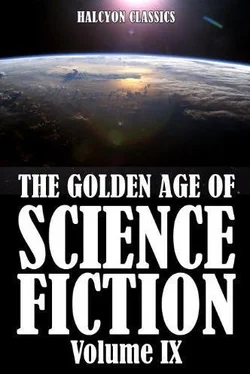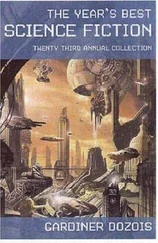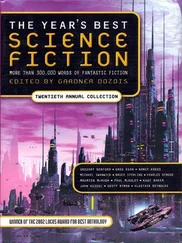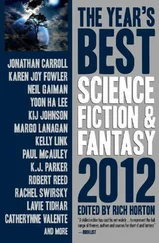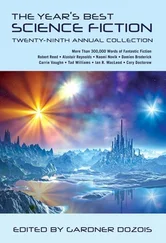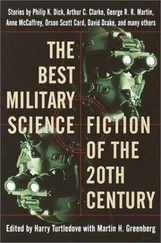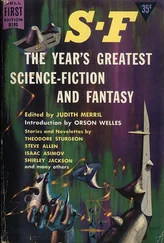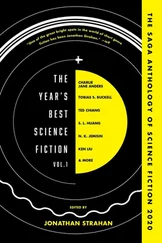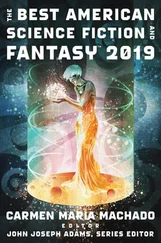Kendall laughed. “You know what to do for an itch. Now, I’m going to make a bet. We had those points separated for a half-million volts discharge, but there was a dust-cover thrown over them just now. That, you notice, is missing. I’ll bet that served as a starter lead for the main arc. Now I’m going to start that projector thing again, and move the points there through about six inches, and that thing probably won’t start itself.”
* * *
Most of the laboratory staff had collected at the doorway, looking in at the white-hot tungsten discharge points, and the now silent “atomic engine.” Kendall turned to them and said: “The flop picked itself up. You go on back, we seem to be all in one piece yet. Douglass, you didn’t get any readings, did you?”
Sheepishly, Douglass grinned at him. “Eh—er—no—but I tore my pants. The magnetic field grabbed me and I jumped. They had some steel buttons, and a lot of steel keys—they’re kinda’ hard to keep on now.”
The laboratory staff broke into a roar of laughter, as Douglass, holding up his trousers with both hands was beheld.
“I guess the field worked,” he said.
“I guess maybe it did,” adjudged Kendall solemnly. “We have some rope here if you need it—”
Douglass returned to his post.
Swiftly, Kendall altered the atomic distortion storage apparatus, and returned to the power-board. “Ready?”
“Check.”
Kendall shoved home the switch. The storage device was silent. Only a slight feeling of strain made itself felt, and the sudden noisy hum of a small transformer nearby. “She works, Buck!” Devin called. “The readings check almost exactly.”
“All good then. Now I want to get to that atomic thing. We can let that slide for a little bit—I’ll answer it.”
The telephone had rung noisily. “Kendall Labs—Kendall speaking.”
“This is Superintendent Foster, of the New York Power, Mr. Kendall. We have some trouble just now that we think your operations may be responsible for. The sub-station at North Beaumont blew all the fuses, and threw the breakers at the main station. The men out there said the transformers began howling—”
“Right you are—I’m afraid I did do that. I had no idea that it would reach so far. How far is that from my place here?”
“It’s about a thousand yards, according to the survey maps.”
“Thanks—and I’ll be careful about it. Any damage, I am responsible for? All okay?”
“Yes, sir, Mr. Kendall.”
Kendall hung up. “We stirred up a lot more dust than we expected, Devin. Now let’s start seeing if we can keep track of it. Douglass, how did your readings show?”
“I took them at the ten stations, and here they are. The stations are two feet apart.”
“H-m-m—.5—.55—.6—.7—20—198—5950—6010—6012—5920. Very, very nice—only the darned thing’s got an arm as long as the law. Your readings were about .2, Devin?”
“That’s right.”
“Then these little readings are just leakage. What’s our normal intensity here?”
“About .19. Just a very small fraction less than the readings.”
“Perfect—we have what amounts to a hollow shell of magnetic force—we can move inside, and you can move outside—far enough. But you can’t get a conductor or a magnetic field through it.” He put the readings on the bench, and looked at the apparatus across the room. “Now I want to start right on that other. Douglass, you move that magnetostat apparatus out of the way, and leave just the ‘can-opener’ of ours—the projector. I’m pretty sure that’s what does the deed. Devin, see if you can hunt up some electrostatic voltmeters with a range in the neighborhood of—I think it’ll be about eighty thousand.”
* * *
Rapidly, Douglass was dismounting the apparatus, as Devin started for the stock room. Kendall started making some new connections, reconnecting the apparatus they had intended using on the “atomic engine,” largely high-capacity resistances. He seemed to perform this work mechanically, his mind definitely on something else. Suddenly he stopped, and looked carefully into the receiver of the machine. The metal in it was silvery, liquid, and here and there a floating crystal of the dull red metal. Slowly a smile spread across his face. He turned to Douglass.
“Douglass—ah, you’re through. Get on the trail of MacBride, and get him and his crew to work making half a dozen smaller things like this. Tell ’em they can leave off the tungsten shield. I want different metals in the receiver of each. Use—hmmm—sodium—copper—magnesium—aluminium, iron and chromium. Got it?”
“Yes, sir.” He left, just as Devin returned with a large electrostatic voltmeter.
“I’d like,” said he, “to know how you know the voltage will range around eighty thousand.”
“K-ring excitation potential for mercury. I’m willing to bet that thing simply shoved the whole electron system of the mercury out a notch—that it simply hasn’t any K-ring of electrons now. I’m trying some other metals. Douglass is going to have MacBride make up half a dozen more machines. Machines—they need a name. This—ah—this is an ‘atostor.’ MacBride’s going to make up half a dozen of ’em, and try half a dozen metals. I’m almost certain that’s not mercury in there now, at all. It’s probably element 99 or something like it.”
“It looks like mercury—”
“Certainly. So would 99. Following the periodic table, 99 would probably have an even lower melting point than mercury, be silvery, dense and heavy—and perhaps slightly radioactive. The series under the B family of Group II is Magnesium, Zinc, Cadmium, Mercury—and 99. The melting point is going down all the way, and they’re all silvery metals. I’m going to try copper, and I fully expect it to turn silvery—in fact, to become silver.”
“Then let’s see.” Swiftly they hooked up the apparatus, realigned the projector, and again Kendall took his place at the power-board. As he closed the switch, on no-load, the electrostatic voltmeter flopped over instantly, and steadied at just over 80,000 volts.
“I hate to say ‘I told you so,’” said Kendall. “But let’s hook in a load. Try it on about 100 amps first.”
Devin began cutting in load. The resistors began heating up swiftly as more and more current flowed through them. By not so much as by a vibration of the voltmeter needle, did the apparatus betray any strain as the load mounted swiftly. 100—200—500—1000 amperes. Still, that needle held steady. Finally, with a drain of ten thousand amperes, all the equipment available could handle, the needle was steady as a rock, though the tremendous load of 800,000,000 watts was cut in and out. That, to atoms, atoms by the nonillions, was no appreciable load at all. There was no internal resistance whatever. The perfect accumulator had certainly been discovered.
“I’ll have to call McLaurin—” Kendall hurried away with a broad, broad smile.
“Hello, Tom?”
The telephone rattled in a peeved sort of way. “Yes, it is. What now? And when am I going to see you in a social sort of way again?”
“Not for a long, long time; I’m busy. I’m busy right now as a matter of fact. I’m calling up the vice-president of Faragaut Interplanetary Lines, and I want to place an order.”
“Why bother me? We have clerks, you know, for that sort of thing,” suggested Faragaut in a pained voice.
“Tom, do you know how much I’m worth now?”
“Not much,” replied Faragaut promptly. “What of it? I hear, as a matter of fact that you’re worth even less in a business way. They’re talking quite a lot down this way about an alleged bank you’re setting up on Luna. I hear it’s got more protective devices, and armor than any IP station in the System, that you even had it designed by an IP designer, and have a gang of Colonels and Generals in charge. I also hear that you’ve succeeded in getting rid of money at about one million dollars a day—just slightly shy of that.”
Читать дальше
